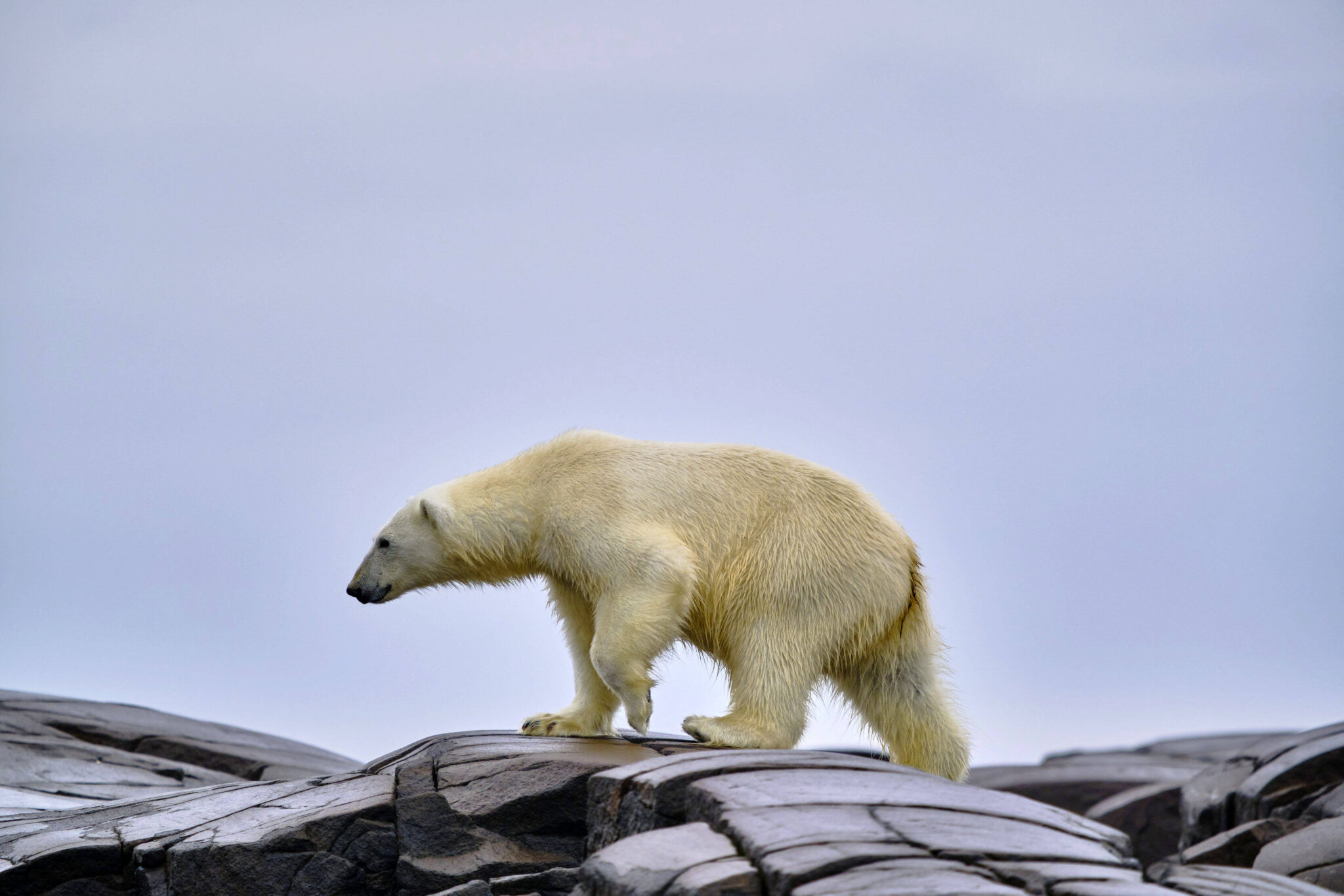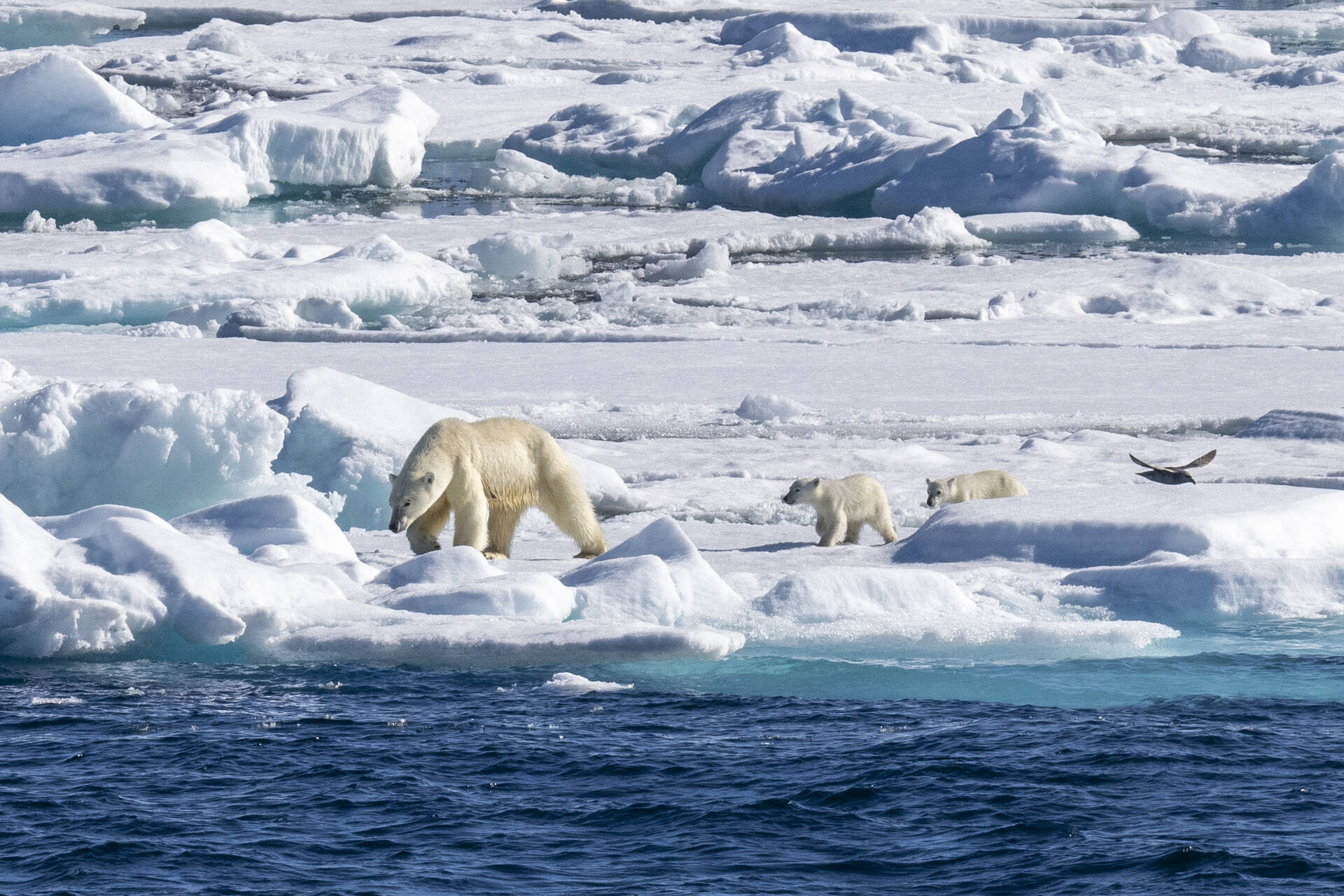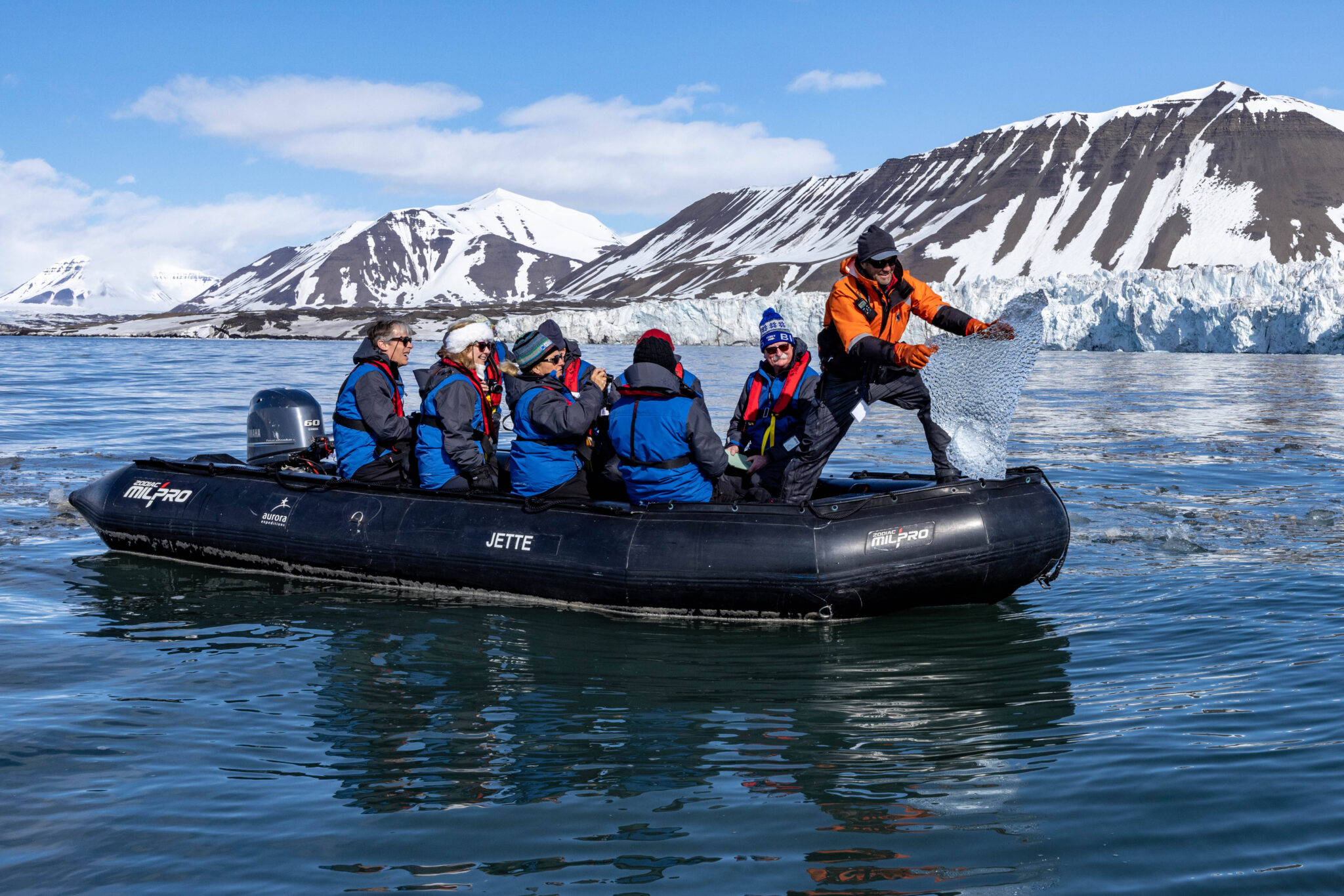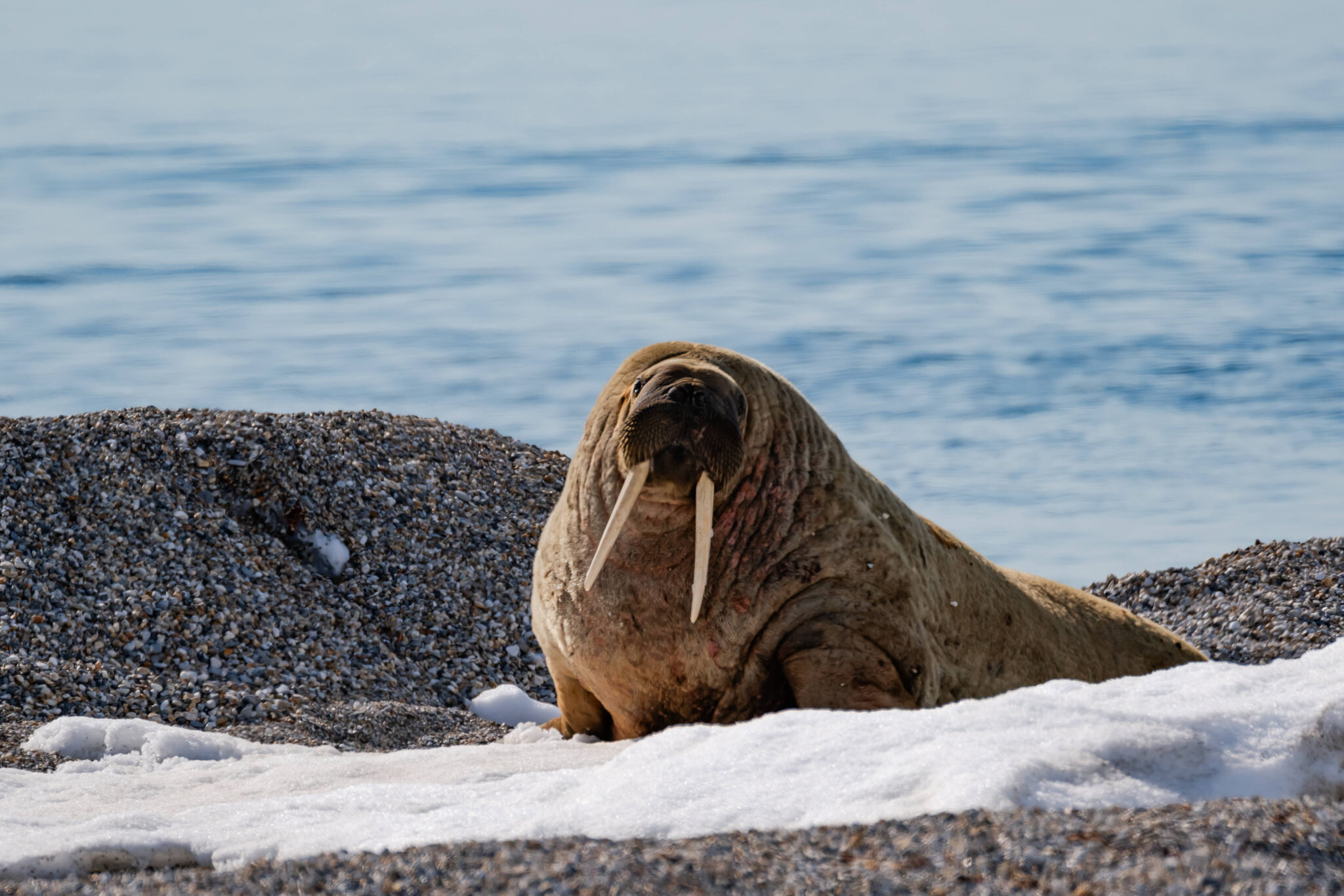You’ve heard that the Norwegian archipelago of Svalbard is one of the coolest places on Earth (literally), and you’re probably keen to be wowed by one of the coolest wildlife experiences on the planet: seeing a Svalbard polar bear!
While you’d need a fortune teller with a crystal ball to precisely know when and where a polar bear will make an appearance, there are some optimal periods to maximise your chances of seeing Ursus maritimus (Latin for sea bear) in its natural habitat.
In this handy guide on the best time to see polar bears in Svalbard, we share all the tips, tricks and fun facts to prepare you for one of the planet’s most thrilling adventures.
The best time to visit polar bears in Svalbard
Svalbard’s frigid winter

During winter, where temperatures are often around the –30°C (4°F) mark, Svalbard drastically transforms into a harsher and more hostile environment.
The thickening sea ice not only creates challenges for ships (even purpose-built ships like ours) but for Svalbard polar bears, too. As their ability to hunt diminishes, these elite Arctic predators have to rely on stored fat reserves, retreating to shelter to conserve energy.
Attempting polar bear spotting in winter is akin to scaling Mt Everest in thick fog and, as such, expedition travel to Svalbard in winter is not recommended.
Exploring in summer
Aurora Expeditions sets sail to Svalbard between May and September, when the sun shines for extended days, enabling passage through the melting sea ice. Come June and July, the wildlife in Svalbard is active, and the Arctic tundra presents a beautiful bloom. With seven expeditions to Svalbard and over 15 annual departures, there are ample opportunities to witness the King of the Arctic in its natural environment.
As the sun melts the sea ice – a habitat Svalbard polar bears rely on – they migrate to the islands to search of food. With 24/7 daylight from 20 April to 22 August, summer is the best time to visit Svalbard to see polar bears.
As the world’s largest land carnivore, males can weigh up to 600 kilograms (1,300 pounds) and reach 3 metres (10 feet) tall when standing on their hind legs. Seeing them in action is exhilarating – from a safe distance, of course.

Peak months for polar bear sightings
While we can never guarantee a sighting, Svalbard is one of the best places in the world to see polar bears in the wild. With an estimated 3,000 across the Svalbard archipelago and Barents Sea, Svalbard acts like a refuge, providing safety for this endangered species.
Knowing the best time of year to visit Svalbard is a challenge every traveller faces before booking. Our first and last sailings of the summer season are fabulous for those oh-so-Arctic shots of thick pack ice and snowfall, but determining when Svalbard polar bears have started migrating for food can be hit or miss.
From June through to early August, the melting ice means we can push further north, covering more ground, affording our knowledgeable Expedition Team better opportunities to help expeditioners spot a polar bear and track polar bear activity. Find out more about Aurora Expeditions’ commitment to responsible travel and what we’re doing to support polar bears in the wild.
Planning your wildlife adventure
Choosing the right travel company for your Svalbard trip will drastically increase your chances of polar bear sightings. We’ve been operating in the polar regions for over 33 years and in the Arctic for over 27 years, attracting the best Expedition Leaders and onboard experts, passionate about sharing their wisdom with guests.
We know the polar bear is at the top of most travellers’ lists when visiting Svalbard, and we’ll safely and responsibly try to make it happen. Our flexible itineraries make this possible – polar bears willing, of course.
When planning, you’ll want to consider how in-depth you want your Svalbard experience to be. With tours from eight to 24 days, you can choose from our range of sailings that focus solely on Svalbard – like Svalbard in Depth or Svalbard Odyssey – or combine Svalbard with other Arctic destinations, including Iceland and Greenland, like on Arctic Complete or Jewels of the Arctic.
You’ll be travelling on one of our purpose-built expedition ships, the Greg Mortimer or Sylvia Earle. Designed to go deeper into the region, our ships’ X-Bow® design is a game-changer, offering expeditioners a safer, smoother and more enjoyable journey, that’s better for the environment. And with a maximum of 130 passengers and a range of included and optional activities – including kayaking– you’ll be sightseeing across the wilds of the Arctic, not impatiently waiting in a line while wildlife passes.
Our Zodiac boats get us even closer to the action, for those must-have photos of sea cliffs full of hundreds of seabirds, gigantic icebergs and dramatic coastal scenery, and of course to transport you to shore for guided hikes through colourful tundra.
Selecting accommodation in Svalbard
Depending on which of our seven Arctic expeditions you choose, you may be starting your adventure in Svalbard’s capital, Longyearbyen. Not to worry about where to stay, however, as we’ve got your first night’s accommodation in Longyearbyen taken care of in a hand-selected property. For the remainder of your journey, you’ll be in comfort aboard one of our two purpose-built expedition ships!
For extra days in Longyearbyen, talk to our reservations team for advice and be sure to read Svalbard’s best-kept secrets. It includes the town’s most unusual tourist attraction!
Preparing for your Arctic journey
How to pack for the Arctic is not as complex as you may think. In fact, because layering is key, you may already have most of the recommended gear.
You can read a more detailed breakdown here, but here’s our quick guide to packing for your once-in-a-lifetime Arctic journey:
- Layered clothing: include a thermal base layer, insulating mid-layer and waterproof and windproof outer layers. You bring the pants; we’ve got you covered with a complimentary polar expedition jacket, allocated upon boarding.
- Headgear: keep your head, neck and ears warm by packing an insulated or woollen beanie, scarf and sunglasses for that polar glare.
- Hand protection: happy hands, happy (Arctic) life! Woollen gloves under waterproof mittens are best.
- Footwear: we’ll loan you muck boots, so simply bring thick socks to wear inside them. On board, comfy slip-on shoes are our top pick.
- Backpack: bring a waterproof backpack for landings with a dry bag to protect your camera or phone.
- Camera gear: while many travellers take brilliant photos on the latest phones, cameras with long zooms will get you the best images. Add spare batteries, an extra memory card, plus a travel charger.
- Personal care items: individualised to your medication and personal hygiene needs, but items everyone will need include high-SPF sunscreen, UV lip protection, moisturiser, seasick medication and ear plugs if you’re sharing a stateroom (you’re welcome).
- Swimsuit: perfect for the Jacuzzi and sauna but also our daring polar plunge.
- Patience: yes, pack your patience, it’s key to catching a glimpse of any elusive animal in the wild, especially polar bears. As is being silent as we get close.
Safe & responsible tourism
At Aurora Expeditions, we prioritise not only the safety of you, our Expedition Team and crew, but that of the planet, too. Our commitment to sustainability aligns with responsible, sustainable tourism and respect for the places and communities we visit. Our ships are certified 100% climate neutral.
We’ll also invite you to become a Citizen Scientist, on board, during shore expeditions, and in our Zodiacs. You will have the chance to make a difference by providing invaluable data to the scientific community, share new discoveries, deepen your connection to nature, and become a long-standing advocate for the planet.

Enhancing your wildlife adventure experience
With a once-in-a-lifetime opportunity to see a wild Svalbard polar bear, it helps to know how to maximise your experience.
Photography tips for Svalbard’s stunning moments
Whether you’re an amateur or pro photographer, aboard every sailing, you can benefit from wildlife photography tips from an award-winning professional photographer. It’s another reason why travelling with the experts makes sense.
The top tip for polar bear photography in our Arctic Landscape Photography blog is to pack a good zoom lens, ideally with optical stabilisation. Practice these handy photography tips from Aurora Expeditions regular photographer Scott Portelli before you depart. They’ll help prepare you for any (welcome!) Svalbard surprises.
Other wildlife encounters in Svalbard
While polar bears may be the King of the Arctic – both in their rank as a predator and for traveller desirability – they are not the only Arctic wildlife you’ll see when exploring Svalbard.
The “awws” that follow an Arctic fox sighting are sometimes louder than our ship engines! It’s more “oooooh” than “aww” for beluga whale encounters, and watching a walrus loll is cause for a chuckle or two. Reindeer, guillemots, and little auk call Svalbard home, too.
Puffin encounters are another crowd favourite. If you sail on our Iceland, Jan Mayen, and Svalbard expedition you have a good chance of seeing these Parrots of the Sea in multiple destinations.

In summary, if polar bears are your prime reason to visit this Arctic wonderland, the best time to visit Svalbard is on our mid-June to July departures. We recommend choosing a longer tour, like Svalbard in Depth, as the more time you have to play with, the better your chances of disembarking with that Svalbard polar bear shot.
Whenever you go, and whatever wildlife you see, Svalbard is a thrilling destination offering unforgettable adventures across its archipelago.
Ready to explore Svalbard?
Feeling inspired to explore stunning Svalbard to see polar bears (if you’re lucky) and other incredible Arctic wildlife? Book your life changing journey by contacting our team of experts or requesting an online quote. We’ve hand-picked some of our favourites for you below. To view the full range of itineraries, download or order our latest brochure.
Spitsbergen: Realm of the Ice Bear
Polar Expedition
Thank you for joining Aurora Expeditions on our Spitsbergen: Realm of the Ice Bear expedition. Focussing on the largest island of the Svalbard Archipelago, we slice through pack ice to find...
8 Days
From AUD $16,556.00/pp
Svalbard in Depth
Polar Expedition
Welcome to Aurora Expeditions’ Svalbard in Depth expedition. On this extended exploration of the Svalbard archipelago, there is ample time to enjoy the best of this magical region, a world of...
15 Days
From AUD $27,676.00/pp
Svalbard Odyssey
Polar Expedition
Thank you for joining Aurora Expeditions on our Svalbard Odyssey expedition. Enjoy the best of Svalbard, a world of near-endless daylight, where polar bear sightings quicken your pulse, guillemot cries echo...
12 Days
From AUD $23,596.00/pp








